Garden Railroading on a Shoe-string
Running trains in an attractive outdoor setting is fun. Unfortunately, it's easy for prospective hobbyists to get the idea that you have to rob a bank to have any garden railroad worth having. But the truth is, anyone with ingenuity, patience, and willingness to learn can create an enjoyable outdoor setting for their trains without overextending themselves.
In fact, I think some folks have taken it as a challenge to see what they can accomplish with a minimal investment.
Three things worth knowing to start out:
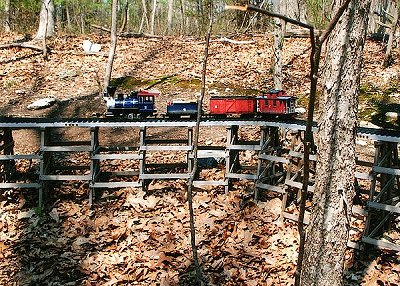 In garden railroading, the setting is just as important as the trains for many people. As the photo to the right shows, a great setting can make even a toy train look good. And creating an attractive setting takes more creativity and hard work than it does money. In garden railroading, the setting is just as important as the trains for many people. As the photo to the right shows, a great setting can make even a toy train look good. And creating an attractive setting takes more creativity and hard work than it does money.
 When modern garden railroading emerged as a growing hobby in North America, most of the trains available looked like toys to most Americans, including the Kalamazoo 4-4-0 shown to the lower right and the LGB Stainz (an actual model that looked toylike to most Americans). When modern garden railroading emerged as a growing hobby in North America, most of the trains available looked like toys to most Americans, including the Kalamazoo 4-4-0 shown to the lower right and the LGB Stainz (an actual model that looked toylike to most Americans).
That didn't stop the hobby from exploding or people from creating compelling, attractive garden railroads.
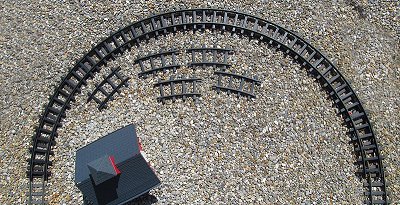 Most of the expensive garden train sets come with a 48"-diameter circle of track. So do most big toy trains from companies like New Bright and Scientific Toys/Ez-tec. Most of the expensive garden train sets come with a 48"-diameter circle of track. So do most big toy trains from companies like New Bright and Scientific Toys/Ez-tec.
So if you build a railroad that will hold the plastic track now, and you upgrade to a garden train later, you won't have to redesign your railroad to convert over to the sort of brass track that comes with LGB, Piko, or AristoCraft train sets.
The following is a quick list of tips that we will expand on further down.
- Make a budget to use as a guideline for purchases.
- Shop carefully; don't buy the first thing that you see. Or even the tenth, unless you know by now it's the best you can do.
- Design thoughtfully.
- Choose materials and methods designed for permanence
- Buy garden plants that you can spread yourself over time.
- Shop autumn nursery closeouts for half-price conifers (evergreens).
- Shop after-Christmas closeouts for toy trains and useful accessories.
- Use your imagination - keep your eyes open for products that you can repurpose.
- Get and keep the family involved.
What's Your Overall Budget?
Most people who buy name-brand garden trains (from LGB, PIKO, etc.) imagine that they've made the "big" investment when they bring the train set home. Then they discover that additional track, water features, landscaping, plants, and accessories cost money, too. Even dirt is not "dirt cheap."
Depending on how much you scrounge and the compromises you're willing to make starting out, you will probably be considering somewhere between $120 and $400 for your first iteration - not including the cost of your first train set. The difference between me and the other writers is that I'm warning you about stuff like this up front.
 Your budget won't look like anybody else's, and you may find some "wiggle room" or encounter additional expenses as you go forward. As examples, you may be able to use "found" materials and plants, or your significant other may have their heart set on a $200 waterfall. Just don't be like the bride with a $50,000 wedding budget who spends $45,000 on the dress and has to have Burger King cater the reception. "Balance" is the key. Your budget won't look like anybody else's, and you may find some "wiggle room" or encounter additional expenses as you go forward. As examples, you may be able to use "found" materials and plants, or your significant other may have their heart set on a $200 waterfall. Just don't be like the bride with a $50,000 wedding budget who spends $45,000 on the dress and has to have Burger King cater the reception. "Balance" is the key.
For more information and tips about budgeting for a "shoe-string" garden railroad check out our article "Budgeting for a Shoe-String Railroad."
Shopping for Trains
 The sturdiest toy trains for this purpose are made by Scientific Toys/Ez-tec and Lionel. That said, many folk have used New Bright, Echo, and other brands of toy trains with success. Our article Garden Railroading with Toy Trains has more information on these brands and more. The sturdiest toy trains for this purpose are made by Scientific Toys/Ez-tec and Lionel. That said, many folk have used New Bright, Echo, and other brands of toy trains with success. Our article Garden Railroading with Toy Trains has more information on these brands and more.
The best time to shop for toy trains is after Christmas, when you can sometimes get them for half price. If you shop the used market, do NOT spend money on any set unless it is guaranteed to run and includes the remote. Most of these trains won't even run without the remote.
Also, don't rush into buying extra cars or track for your set - if it's a popular set you may come across a damaged or incomplete set for less than the cost of extra track alone.
Finally, once you get a toy train operating in the garden, be sure to store it someplace dry when you are not using it. They are much more prone to rust and sun damage than garden trains. Also, take the batteries out if you are leaving the train in storage for more than a few days. Click here for more information.
 Design Thoughtfully Design Thoughtfully
It doesn't cost anything to plan. Even if you have a tiny budget and only a circle of track, you can increase interest by adding features like trestles and tunnels. If you have enough track to make an oval, don't make every square foot of the railroad look the same. Consider putting, say, your "wilderness" on one side or end of the railroad and you "town" on the other side or end. If your railroad is raised, that gives you many more opportunities for interest, since you can have the "ground level" rising and falling around the train.
Choose Infrastructure With a View to the Future
If you just want to try running trains outside, and you're not committed to years of outdoor railroading, you might take a look at our "One-Day Railroad" article. But if you're hoping to run trains for 3 or more years, you should think about "permanent" materials and methods.
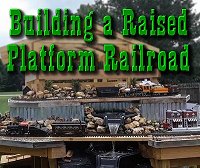 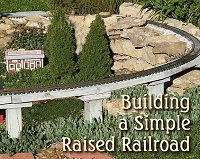 One example is lumber. Even "pressure-treated" lumber can fail in constant contact with damp soil. For that reason, whenever I use lumber, such as in our Simple Raised Railroad or Raised Platform Railroad articles, I use ground-rated lumber throughout. One example is lumber. Even "pressure-treated" lumber can fail in constant contact with damp soil. For that reason, whenever I use lumber, such as in our Simple Raised Railroad or Raised Platform Railroad articles, I use ground-rated lumber throughout.
What about a ground-level railroad? If you plan to run trains there for more than a couple of years, consider cutting a 6"x6" trench and filling it with crack-resistant concrete. The "gravel in a trench" method espoused by many early writers only works indefinitely in regions with limited rainfall and no burrowing animals to speak of.
You wouldn't use inferior lumber or "quick-and-dirty" methods if you were building a deck or patio. Don't cheat your trains either.
Even inexpensive trains run better on a solid, level roadbed. And once you have a reliable infrastructure in place, it can handle almost any kind of train you buy in the future.
Shopping for Trees
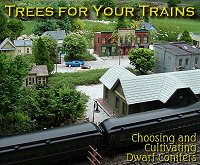 If you can be satisfied with just a few trees at first, try watching for sales after Labor Day. You have to move fast, because landscapers do this all the time - they can get trees cheaper at half-off sales than they can get them from wholesalers. Look for trees that list around $10 that you can get for $5. If you can be satisfied with just a few trees at first, try watching for sales after Labor Day. You have to move fast, because landscapers do this all the time - they can get trees cheaper at half-off sales than they can get them from wholesalers. Look for trees that list around $10 that you can get for $5.
In many states, the most popular tree for garden railroads is Dwarf Alberta Spruce, but you can try others - just try to avoid anything that gets really big really fast.
For more suggestions, check out our article "Trees for Your Trains."
Shopping for Groundcovers
Don't feel bad about having mostly mulch or gravel for your groundcover when you're starting out. In fact, that's better than planting something that's invasive in your region and having to rip it out.
 In places that get rainfall like Ohio, a single start of Sedum or Thyme may populate several square feet in a few years. I like low-growing Sedums like "Stubby Fingers" and "Acre," though I also use other varieties. Low growing Thymes, such as "Creeping Thymes," Elfin Thyme, and Woolly Thyme are nice, too, though they usually spread more slowly and have zero tolerance for standing water. In places that get rainfall like Ohio, a single start of Sedum or Thyme may populate several square feet in a few years. I like low-growing Sedums like "Stubby Fingers" and "Acre," though I also use other varieties. Low growing Thymes, such as "Creeping Thymes," Elfin Thyme, and Woolly Thyme are nice, too, though they usually spread more slowly and have zero tolerance for standing water.
Often gardeners and garden railroaders have to cut back their Sedums and are glad to give you starts for free, hint, hint. There is a lot more information about groundcovers in our article "Groundcover 101."
Use Your Imagination
Keep your eye out for products you can repurpose to use in place of expensive accessories. These include toys, Christmas village accessories, and pieces borrowed from other scales.
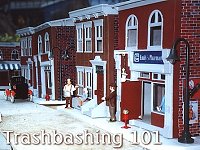 Trashbashing is my name for repurposing something that started out as a discarded toy into a model of some kind. I started out doing this with damaged and worn out toy buildings back in the days when all buildings being made for garden trains looked like they belonged in the Alps. Those toys are no longer available, really, but others have come and gone since. See our articles "Trashbashing 101" and "Trashbashing Step-by-Step" for more information. Trashbashing is my name for repurposing something that started out as a discarded toy into a model of some kind. I started out doing this with damaged and worn out toy buildings back in the days when all buildings being made for garden trains looked like they belonged in the Alps. Those toys are no longer available, really, but others have come and gone since. See our articles "Trashbashing 101" and "Trashbashing Step-by-Step" for more information.
Christmas Village Figures and Accessories from companies like Lemax aren't cheap, but they're a lot cheaper than the "name brand" figures made for garden railroads. I shop for them after Christmas at places like Lowes that have no intention of keeping their stock around past New Years' Day.
 Cheap Asian Figures - The photo to the right shows some inexpensive Chinese-made figures that I ordered from eBay and glued to clear plastic salvaged from store packaging. The paint jobs are sloppy, and you'll get multiple figures with the same pose, but they're an inexpensive way to populate your communities quickly. Cheap Asian Figures - The photo to the right shows some inexpensive Chinese-made figures that I ordered from eBay and glued to clear plastic salvaged from store packaging. The paint jobs are sloppy, and you'll get multiple figures with the same pose, but they're an inexpensive way to populate your communities quickly.
For other ideas about scrounging figures check out our articles "Figures and Details for your Garden Railroad" and "More about Scrounging Figures." The latter article includes tips on using the sort of figures shown at the right.
Items "Borrowed" From Other Scales" - When I trashbashed my first set of city street buildings, I added street lights that were made for O gauge railroads, but had the right proportion for my buildings. Sadly, they're not made any more, but other useful accessories still turn up from time to time.
Items "Borrowed" From Other "Outdoor" Uses - Bird feeders, fairy garden pieces, etc.
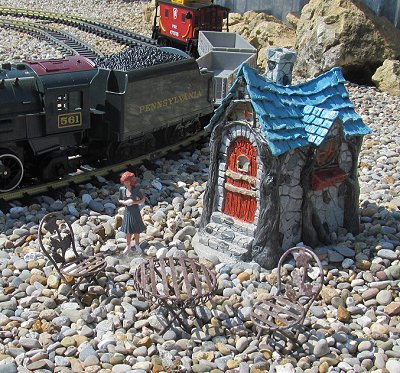 Resin accessories, like the fairy garden cabin in the photo to the right, are made to last 2-3 summers, but you can extend their life if you coat them thoroughly with UV-resistant spray finish before setting them out each summer. Also, you will probably need to touch up the paint every so often. The metal bistro set needs similar protection to keep it from rusting out. Resin accessories, like the fairy garden cabin in the photo to the right, are made to last 2-3 summers, but you can extend their life if you coat them thoroughly with UV-resistant spray finish before setting them out each summer. Also, you will probably need to touch up the paint every so often. The metal bistro set needs similar protection to keep it from rusting out.
The cheap Chinese figure is one my daughter Molly hand-painted, glued to a piece of flat PETE scrounged from packaging material.
Those wooden "bird feeders" and "bird houses" with the cutesy details aren't really made to be used outside - for one thing, the glue they use is often water soluble. But you COULD hit them with a UV-resistant clear coat and set them out just when you're running trains.
In the photo below, I've included one of those cheap Chinese figures to give you a sense of scale. Most of these structures are smaller than the one shown. You could consider carrying a 1:24 figure in your pocket when you go shopping until you get a sense of such things.

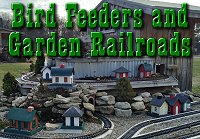 I have a collection of North State's bird feeders that I set out in the winter so my railroad doesn't look so naked when my model buildings come in. A few of them are actually close to the scale you need, and would be usable year-round, even on a scale railroad with mostly model buildings. For ideas and reviews, check out our article "Bird Feeders and Garden Railroads.", but I won't go into great detail because they come and go quickly. I have a collection of North State's bird feeders that I set out in the winter so my railroad doesn't look so naked when my model buildings come in. A few of them are actually close to the scale you need, and would be usable year-round, even on a scale railroad with mostly model buildings. For ideas and reviews, check out our article "Bird Feeders and Garden Railroads.", but I won't go into great detail because they come and go quickly.

Experienced garden railroaders have no trouble recognizing that these are "low-budget" items. But the truth is, most non-railroading visitors would have no idea that you spent hundreds, not thousands, on this sort of setup.
"Roll Your Own"
Creating your own buildings and accessories isn't out of the question, either. I hope to have more articles on this eventually. (The fact is, I've tried several things that almost worked, but I'm trying to work out the bugs before I post them here.)
Get and Keep the Family Involved
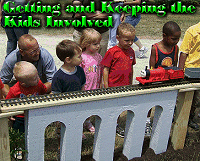 Most kids love operating the train and setting out the little figures. Some will enjoy helping you build or paint things. Other family members may enjoy the gardening aspects, or entertaining visitors who come to see the trains run. Most kids love operating the train and setting out the little figures. Some will enjoy helping you build or paint things. Other family members may enjoy the gardening aspects, or entertaining visitors who come to see the trains run.
Our article "Getting and Keeping the Kids Involved" has more suggestions for helping to make garden railroading a family interest.
Conclusion
I hope this article helps you plan and build an outdoor railroad, even if you don't have more money than you know what to do with.
Do you have any new finds, techniques or recommendation you'd like to add to our information? If you do, especially if you can come up with how-to descriptions and photos, please get in touch. I'd love to post them here.
Here are other articles with tips and tricks about running battery-powered toy trains outside.
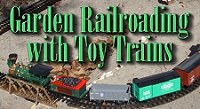 Garden Railroading with Toy Trains - For more information about garden railroading with toy trains, including brand descriptions, buying advice, etc., click on the little picture to the right. Garden Railroading with Toy Trains - For more information about garden railroading with toy trains, including brand descriptions, buying advice, etc., click on the little picture to the right.

Budgeting for a Shoe-String Garden Railroad - Lists potential expenses most folks don't think about ahead of time, along with ways to reduce or skirt them with planning.
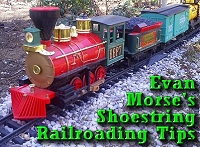
Evan Morse's Shoestring Railroading Tips - Things that work for one Shoestring Railroader, mostly about track.

Converting Lionel's "Ready to Play" Trains to 45mm - Lionel's current line of battery-powered toy trains run on 2" track. But they don't have to.

Lionel's G Gauge Toy Trains - All about the battery-powered G gauge toy trains Lionel made in the 2011-2015 period. Most are a great choice for a "shoe-string" railroad.
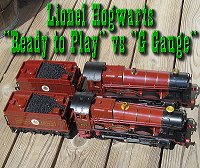
Comparing Lionel's Hogwarts Express Versions - Click for a 'hands-on" comparison of Lionel's two battery-powered Hogwarts Express trains. Here's a quick summary: the passenger car molds are the same; the locomotive molds are different, because the batteries in the "Ready-to-Play" version are in the locomotive. That means it runs more reliably, but it requires 2" track.
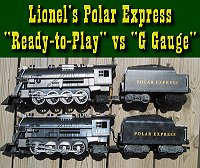
Comparing Lionel's Polar Express Versions - Click for a 'hands-on" comparison of Lionel's two battery-powered Polar Express trains. Here's a quick summary: the passenger car shell molds are the same; the trucks of the cars and tender are different, the locomotive molds and chassis widths are different.
Also, TBH, the Ready-to-Play version, which requires 2" track, stays on the track better than the G-gauge version, because the batteries are in the locomotive.
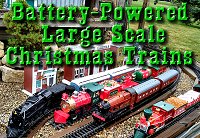 Battery-Powered Large Scale Christmas Trains - Countless battery-powered Large Scale Christmas trains have been released. Even the discontinued ones are mostly available. They're built on the same chassis as the non-Christmas trains, so you'll fine a wealth of information here, even if you're not looking for Christmas trains specifically. Click on the picture for more information. Battery-Powered Large Scale Christmas Trains - Countless battery-powered Large Scale Christmas trains have been released. Even the discontinued ones are mostly available. They're built on the same chassis as the non-Christmas trains, so you'll fine a wealth of information here, even if you're not looking for Christmas trains specifically. Click on the picture for more information.

Into the Woods - a Geo-cacher builds an elaborate trestle-based dogbone railroad in a forest, then locks up a Scientific Toys/Ez-Tec train set with clues that fellow geocachers can use to get the train out and run it.
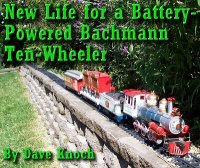
New Life for a Battery-Powered Bachmann Ten-Wheeler - Lose the remote?
You can use these tips to add directional switching to battery-powered locomotives.
| 
























 The sturdiest toy trains for this purpose are made by Scientific Toys/Ez-tec and Lionel. That said, many folk have used New Bright, Echo, and other brands of toy trains with success. Our article Garden Railroading with Toy Trains has more information on these brands and more.
The sturdiest toy trains for this purpose are made by Scientific Toys/Ez-tec and Lionel. That said, many folk have used New Bright, Echo, and other brands of toy trains with success. Our article Garden Railroading with Toy Trains has more information on these brands and more.











































